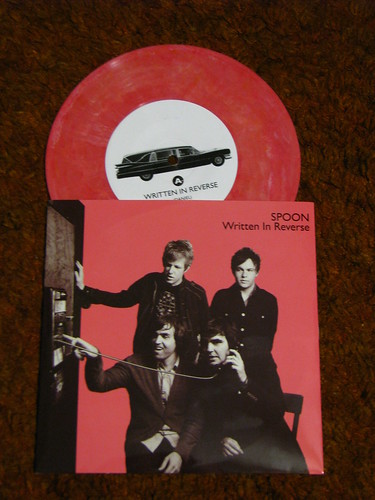So, my copy of the new Spoon single, "Written in Reverse ," arrived today on colored 7-inch vinyl, and it is gorgeous, as you can see:
," arrived today on colored 7-inch vinyl, and it is gorgeous, as you can see:

Handling the single, and already eagerly anticipating the release of Spoon's next album, Transference , on January 19, I began to think of the relationship of 7-inch singles to albums and EPs, and specifically about the place of 7-inch singles in the contemporary, increasingly digitized music industry. While I think that the continued presence of (and even increased popularity of) the 12-inch album and, to a lesser degree, the 10-inch EP in the musical environment has been vindicated to a point where acceptance of vinyl in the mainstream is not a radical concept, the 7-inch presents a quandary. While albums and EPs are collections of songs that are meant to be listened to together, and often play for 15 to 20 minutes per side without the interruption of having to flip the record, singles are another story entirely. I mean, was there ever a time when the single would have been considered convenient? It really is the most work-intensive method of listening to music; considering that a typical pop single traditionally clocks in at around 3 minutes, and sometimes even less, it seems that one would hardly have time to sit down and make oneself comfortable before it would be time to get up and flip he single over to the B-side. Is the continued existence of the 7-inch single simply a byproduct of superficial nostalgia and vinyl fetishism?
, on January 19, I began to think of the relationship of 7-inch singles to albums and EPs, and specifically about the place of 7-inch singles in the contemporary, increasingly digitized music industry. While I think that the continued presence of (and even increased popularity of) the 12-inch album and, to a lesser degree, the 10-inch EP in the musical environment has been vindicated to a point where acceptance of vinyl in the mainstream is not a radical concept, the 7-inch presents a quandary. While albums and EPs are collections of songs that are meant to be listened to together, and often play for 15 to 20 minutes per side without the interruption of having to flip the record, singles are another story entirely. I mean, was there ever a time when the single would have been considered convenient? It really is the most work-intensive method of listening to music; considering that a typical pop single traditionally clocks in at around 3 minutes, and sometimes even less, it seems that one would hardly have time to sit down and make oneself comfortable before it would be time to get up and flip he single over to the B-side. Is the continued existence of the 7-inch single simply a byproduct of superficial nostalgia and vinyl fetishism?
Strictly speaking, the more I think about it, the existence of singles doesn't make sense. It just seems counter-intuitive. Aside from the whole flipping sides issue, there is the simple economics of it. In an age of 99-cent digital track downloads, $10 full-album downloads, and new release CDs often offered for $7.99 at the big box stores, what incentive is there for music fans to put down five dollars (or more) on two songs? Especially in the current economic climate, it does not seem to be a particularly sustainable model.
When one looks at the way the music industry is structured, the very idea of a single (at least in the traditional definition) also appears to be bordering on archaic, and charting the recent history of the single proves to be quite illuminating in terms of how the music industry has changed over the years. At this point it should be noted that I am not claiming to be a music historian, nor is this an academic blog, and so my understanding may be flawed or my explanations oversimplified or generalized to a degree where I miss the point. I do believe, however, that my overall argument, that the single has largely gone from being its own entity to a promotional tool for a more expensive album to an afterthought on the verge of antiquity, holds true.
My look at singles will begin in the 1960s, when it seems that the UK and US music industries had very different ideas of the purpose of singles. Bands such as the Beatles, Rolling Stones, and Jimi Hendrix Experience often looked at singles and albums as separate and yet equally legitimate entities. It had been common practice (and a practice that was sometimes adopted in the late '70s UK punk and postpunk scenes, as evidenced by a glance at the discographies of bands such as the Clash, Joy Division, and New Order) to eschew including tracks from singes on album releases on the UK pressings of albums. A single seemed to be viewed more as a self-contained statement in itself than simply a building block for a larger statement or entity. However, the corresponding American releases of these albums, which were often delayed, frequently consisted of bastardized tracklistings, with the tracks often resequenced and some album cuts excised from the running order in order to make room for the more recognizable hit singles which would be used to sell the album to the American market. This is the reason so many early Beatles and Rolling Stones albums (not to mention, notoriously, Jimi Hendrix Experience's Are You Experienced and the self-titled debut
and the self-titled debut from the Clash) had sometimes drastically different tracklistings in the UK and US pressings.
from the Clash) had sometimes drastically different tracklistings in the UK and US pressings.
Moving into the '70s and '80s, singles by and large tended to be culled from an album and sent to radio as a kind of promotional tool for the album. Frequently (as evidenced by my own nonscientific "research," i.e., browsing my record collection), even the B-sides of singles during this period were culled from the album, sometimes in slightly remixed form. Clearly, during this period of heavy AOR, singles were merely used as a tool for selling an album, although some bands, primarily in the UK, continued the tradition of releasing standalone one-off singles.
In the 1990s, the single seemed to enter a golden age of sorts as CDs became more and more ubiquitous (we shall conveniently ignore the "cassingle" trend). In the US the "maxi-single," which often contained 2 to 5 "B-sides" - the term stuck in spite of the fact that it no longer made any sense - became the standard format for CD singles. Record labels in the UK, however, engineered an even more effective way of wringing money from the record-buying public: the 2-part CD single (later to expand even more extravagantly into a 3-part CD single, sometimes augmented with a separate DVD single and a limited edition 7-inch with an exclusive B-side). Artists such as Radiohead and Björk released some of the iconic multi-part cd singles, often in several different formats across various European territories. A song such as Radiohead's "High and Dry," for instance, was released in, I believe, about 6 different formats, each with a different selection and configuration of B-sides and none collecting them all in one place.
Moving into the aughts and the rise of the digital marketplace, the concept of a single has become almost outdated, almost a quaint relic. CD singles have all but disappeared from the shelves, with the live cuts, outtakes, and remixes that previously would have been CD single fodder now being relegated to deluxe editions of new albums or to "digital EPs." Digital album leaks have rendered the advance single obsolete, although bands will still frequently pre-release one track from their next album digitally as a teaser. With MTV and VH1 basically being reality television channels these days, and with the rise of streaming video websites, video directors are now free to go places that network execs and the FCC would never allow them to go before, and videos are frequently now more a process of artistic statement than album promotion. With the iTunes model of cherry-picking tracks, the labels have lost control of what tracks to emphasize in order to market an album, which would seem to make the process of music marketing more democratic and egalitarian. The trade-off, however, is that the artist no longer has much control over how the package is presented. An album such as The Hazards of Love by the Decemberists, for instance, relies on its careful sequencing and on being presented as a whole rather than piecemeal by track; while this may be an extreme example, it perfectly displays the artistic loss that unfortunately seems to go hand-in-hand with the digital movement.
by the Decemberists, for instance, relies on its careful sequencing and on being presented as a whole rather than piecemeal by track; while this may be an extreme example, it perfectly displays the artistic loss that unfortunately seems to go hand-in-hand with the digital movement.
Ultimately, artistic presentation is the charm of the 7-inch single, and it is something that I firmly believe the digital file will never be able to replicate. Yes, there is an element of vinyl fetishism involved in the 7-inch single. Yes, there is perhaps some misplaced but well-meaning nostalgia, some willful anachronism. But ultimately it is about the music. As wasteful as the constant side-flipping seems to be, there is something to be said for the concise presentation, the self-contained quality of the package. There is a charm to these two songs that someone thought belonged together on a small slab of vinyl. It's a diversion from the other big, pressing things of the day. It feels special. And, really, when you get all this AND it's on ultra-cute pink marbled vinyl, really, could anybody with a pulse resist it?




